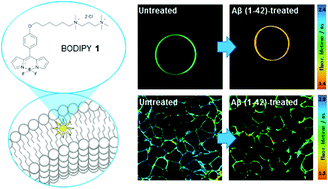Molecular rotors report on changes in live cell plasma membrane microviscosity upon interaction with beta-amyloid aggregates†
Abstract
Amyloid deposits of aggregated beta-amyloid Aβ(1–42) peptides are a pathological hallmark of Alzheimer's disease. Aβ(1–42) aggregates are known to induce biophysical alterations in cells, including disruption of plasma membranes. We investigated the microviscosity of plasma membranes upon interaction with oligomeric and fibrillar forms of Aβ(1–42). Viscosity-sensing fluorophores termed molecular rotors were utilised to directly measure the microviscosities of giant plasma membrane vesicles (GPMVs) and plasma membranes of live SH-SY5Y and HeLa cells. The fluorescence lifetimes of membrane-inserting BODIPY-based molecular rotors revealed a decrease in bilayer microviscosity upon incubation with Aβ(1–42) oligomers, while fibrillar Aβ(1–42) did not significantly affect the microviscosity of the bilayer. In addition, we demonstrate that the neuroprotective peptide H3 counteracts the microviscosity change induced by Aβ(1–42) oligomers, suggesting the utility of H3 as a neuroprotective therapeutic agent in neurodegenerative disorders and indicating that ligand-induced membrane stabilisation may be a possible mechanism of neuroprotection during neurodegenerative disorders such as Alzheimer's disease.



 Please wait while we load your content...
Please wait while we load your content...